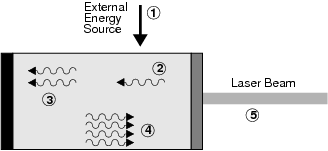| << Chapter < Page | Chapter >> Page > |

Therefore, materials used to make laser light must must have metastable states which can allow population inversion to occur when an external energy source is applied. Some substances which are used to make lasers are listed in [link] . You can see that gases (such as Helium-Neon mixture), liquids (such as dyes), and solids (such as the precious stone ruby) are all used to make lasers.
| Material | Type | Wavelength | Uses |
| Helium–Neon | gas | 632,8 nm | scientific research, holography |
| Argon ion | gas | 488,0 nm | medicine, |
| Carbon dioxide | gas | 10,6 m | industry (cutting, welding), surgery |
| Helium–Cadmium | vapor | 325 nm | printing, scientific research |
| Ruby | solid–state | 694,3 nm | holography |
| Neodymium YAG (Yttrium Aluminium Garnet) | solid–state | 1,064 m | industry, surgery, research |
| Titanium–Sapphire | solid–state | 650–1100 nm | research |
| Laser diode | semiconductor | 375–1080 nm | telecommunications, industry, |
| printing, CD players, laser pointers |
The first working laser, using synthetic ruby as the laser material, was made by Theodore H. Maiman at Hughes Research Laboratories in Malibu, California. Later in the same year the Iranian physicist Ali Javan, together with William Bennet and Donald Herriot, made the first gas laser using helium and neon. Javan received the Albert Einstein Award in 1993.
A laser consists of a number of different parts that work together to create the laser beam. [link] shows the different parts of the laser, while [link] shows how they create the laser beam.


The basis of the laser is the laser material which consists of the atoms that are used to create the laser beam. Many different materials can be used as laser material, and their energy levels determine the characteristics of the laser. Some examples of different lasers are shown in [link] . The laser material is contained in the optical cavity.
Before the laser is turned on, all the atoms in the laser material are in their ground state. The first step in creating a laser beam is to add energy to the laser material to raise most of the electrons into an excited metastable state. This is called pumping the laser.
The creation of the laser beam starts through the process of spontaneous emission , shown in [link] . An electron drops down to the ground state and emits a photon with energy equal to the energy difference of the two energy levels. This laser photon is the beginning of the laser beam.

Notification Switch
Would you like to follow the 'Siyavula textbooks: grade 12 physical science' conversation and receive update notifications?